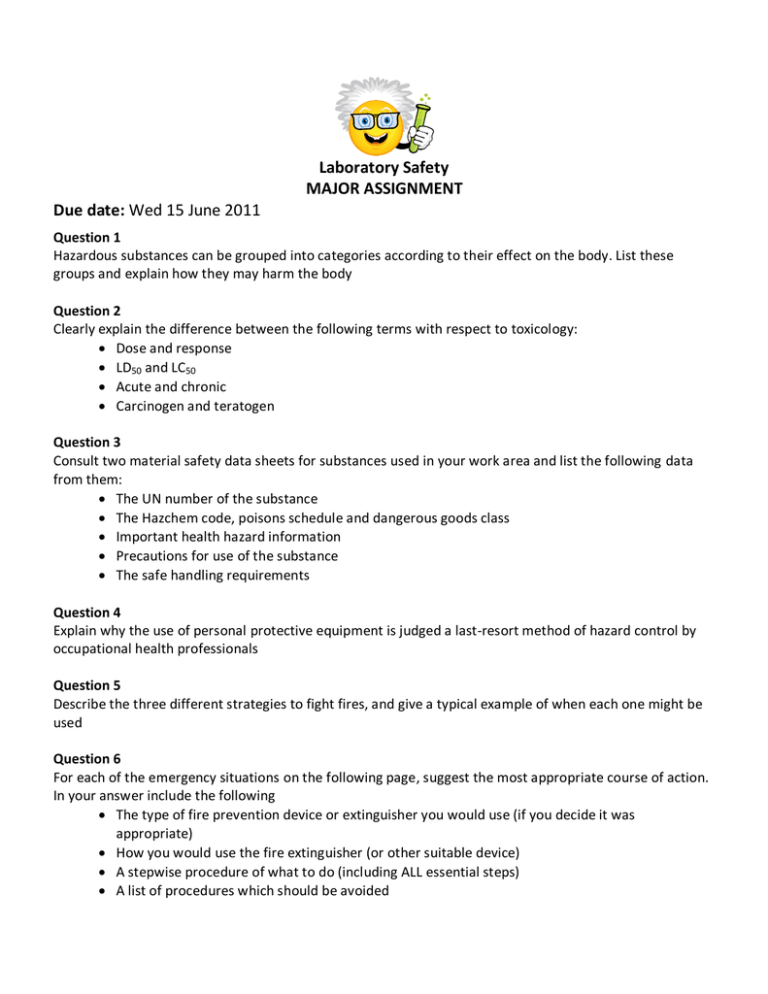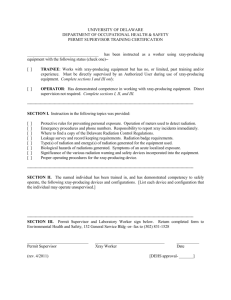Laboratory Safety MAJOR ASSIGNMENT Due date:
advertisement

Laboratory Safety MAJOR ASSIGNMENT Due date: Wed 15 June 2011 Question 1 Hazardous substances can be grouped into categories according to their effect on the body. List these groups and explain how they may harm the body Question 2 Clearly explain the difference between the following terms with respect to toxicology: Dose and response LD50 and LC50 Acute and chronic Carcinogen and teratogen Question 3 Consult two material safety data sheets for substances used in your work area and list the following data from them: The UN number of the substance The Hazchem code, poisons schedule and dangerous goods class Important health hazard information Precautions for use of the substance The safe handling requirements Question 4 Explain why the use of personal protective equipment is judged a last-resort method of hazard control by occupational health professionals Question 5 Describe the three different strategies to fight fires, and give a typical example of when each one might be used Question 6 For each of the emergency situations on the following page, suggest the most appropriate course of action. In your answer include the following The type of fire prevention device or extinguisher you would use (if you decide it was appropriate) How you would use the fire extinguisher (or other suitable device) A stepwise procedure of what to do (including ALL essential steps) A list of procedures which should be avoided a) You open the door of a small office and notice there is a small fire in the wastepaper bin b) You are working in an organic chemical laboratory and a person splashes solvent on their lab coat which is ignited by a naked flame nearby c) A large chemical store inside your building catches fire. It is not noticed until you stumble upon it, by which time the entire room is engulfed in flames. d) You are working in a radiological laboratory on an X-ray machine, when the power supply catches fire. Sparks are clearly seen emanating from the device which seems to be shorting out onto a nearby metal object. Question 7 Explain why a current flow of 100-200 mA through a human body is very often fatal, while larger current flows (sustained for the same period) often do not cause death. Question 8 Suggest reasons why those who work with dangerous electrical devices on a routine basis often carry out the following procedures: Work with one hand in their pocket Stand on insulated rubber mats Never wear metal jewellery Touch all devices with the back of their hand before picking them up Wear rubber-soled shoes and leather gloves Question 9 The terms irritant, sensitiser and lachrymator, may be found on chemical labels or MSDS’s. Explain the meaning of each of these terms and highlight how they differ from one another. Question 10 List all the common types of substances which should not be disposed of down the sink Question 11 Describe the reasons why biological materials pose special risks beyond those of normal chemical or physical hazards Question 12 Clearly explain the difference between each of the terms listed below: Sterilisation and sanitation Disinfection and decontamination Microbiostatis and contact time Question 13 Explain why radiation can be used to treat cancer cells, even though chronic exposure to radiation may cause cancer. Question 14 Three factors determine the type of effect that radiation will have on a person. List these three factors and explain how they lead to different effects on human health. Question 15 Outline the most appropriate course of action which should be followed by the first aider in the emergency situations listed below: You enter a laboratory and notice a worker slumped over a piece of equipment which is obviously still switched on. The person does not respond when called. A pungent electrical odour fills the air While working in a chemical pilot plant for corrosive acid production you hear a shriek from a worker nearby who is holding their eye (and not wearing any safety glasses). A liquid appears to be running down their face After a severe accident in the workplace where a worker has been killed, you notice another worker who witnessed the accident feeling unwell. They are complaining of being tired, and have a rapid weak pulse, and blue tinge to the lips and fingernails.



